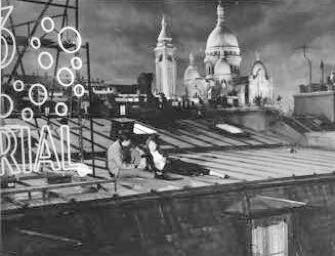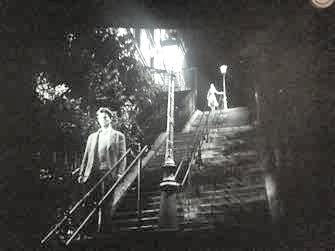
“Montmartre is both heaven and hell,” says the narrator in Jean-Pierre Melville’s 1956 film Bob le Flambeur. Some might consider the charming Butte Montmartre, the hill itself, as heaven and the sin city of Pigalle below as hell. Or vice versa.
In any case, filmmakers have taken advantage of both the picturesque and sleazy sides of Paris’s highest peak to make some memorable films set in the “village” that is Montmartre.
The exhibition “Montmartre: Décor de Cinéma” (“Montmartre: A Film Set”) at the Musée de Montmartre takes us on a long stroll up and down the hill for peeps at excerpts and stills from many of the nearly one thousand films that have been made in the area, beginning with Le Rembrandt de la Rue Lepic, made in 1910 by Jean Durand, in which an artist who looks suspiciously like Toulouse-Lautrec sells a “genuine Rembrandt” for 35 francs to a couple of rubes in a Montmartre café. Three years later, the same director shot Onesime Débute au Théâtre, which includes a wild chase scene across the rooftops of Montmartre.
The Sacré-Cœur, completed around the same time as cinema was born, provided directors with a handy shortcut for pinpointing the location of their films, while the steep staircases of Montmartre, with their quaint lampposts, made a dramatic backdrop for action scenes like the young Antoine Doinel and his friend bounding down the steps four by four in François Truffaut’s masterpiece Les Quatre Cents Coups (The 400 Blows, 1959).
Later Truffaut films, Baisers Volés (Stolen Kisses, 1968) and L’Amour en Fuite (Love on the Run, 1979), also set in Montmartre, feature a grown-up Doinel, the director’s doppelgänger. (Truffaut himself, who died too young, in 1984, rests in peace, we hope, in the Montmartre Cemetery.)

In a film I didn’t know, the black-and-white Juliette ou la Clef des Songes (1951), Marcel Carné used one of the staircases to brilliant effect in a night shot in which a young blonde woman stands like a statue under the lamplight at the top of a staircase watching her fleeing lover, who is lit by another lamp halfway down.

This is one of the few scenes for which Carné used a real location; he preferred to build identical copies in the studio, as he did for Hôtel du Nord (1938) and Les Portes de la Nuit (Gates of the Night, 1946), for which he re-created the Barbès-Rochechouart Métro station and filmed scenes of shady men selling contraband to passersby. Plus ça change…
The “down-below” worlds of the Moulin Rouge and sexual commerce are represented by such films as Jean Renoir’s French Cancan (1955) and Karim Dridi’s Pigalle (1974).

Other spotlighted films include An American in Paris (1951), in which Gene Kelly plays a dancing and singing artist who sells his paintings on the Place du Tertre, and, of course, Amélie (2001), the film that revived the world’s (and especially Americans’) love affair with Montmartre and added a new layer of tourist attractions to the hill that hosted so many bohemian icons. A number of props from the film are on show, including Amélie’s lamp in the form of a pig in a suit.
After seeing the exhibition, you will want to seek out the films you missed and re-see those you have seen and loved. And, of course, you will want to revisit Montmartre, beginning with a stroll through the museum’s beautiful gardens.
Favorite